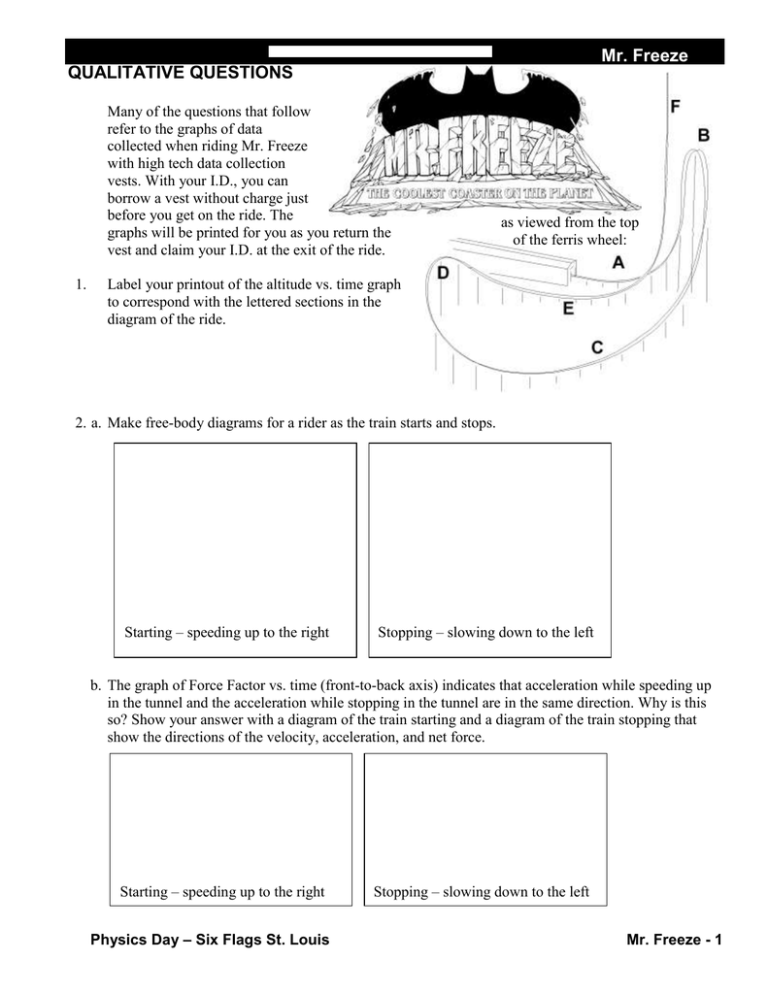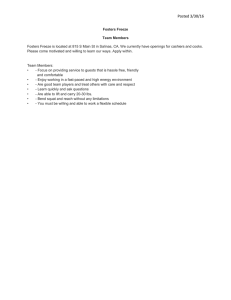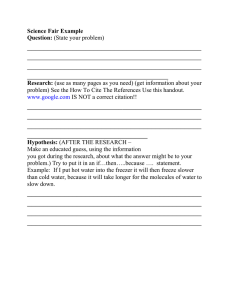Mr. Freeze QUALITATIVE QUESTIONS
advertisement

Mr. Freeze QUALITATIVE QUESTIONS Many of the questions that follow refer to the graphs of data collected when riding Mr. Freeze with high tech data collection vests. With your I.D., you can borrow a vest without charge just before you get on the ride. The graphs will be printed for you as you return the vest and claim your I.D. at the exit of the ride. 1. as viewed from the top of the ferris wheel: Label your printout of the altitude vs. time graph to correspond with the lettered sections in the diagram of the ride. 2. a. Make free-body diagrams for a rider as the train starts and stops. Starting – speeding up to the right Stopping – slowing down to the left b. The graph of Force Factor vs. time (front-to-back axis) indicates that acceleration while speeding up in the tunnel and the acceleration while stopping in the tunnel are in the same direction. Why is this so? Show your answer with a diagram of the train starting and a diagram of the train stopping that show the directions of the velocity, acceleration, and net force. Starting – speeding up to the right Physics Day – Six Flags St. Louis Stopping – slowing down to the left Mr. Freeze - 1 Mr. Freeze QUALITATIVE QUESTIONS (continued) 3. e. Immediately after the train comes out of the horizontal tunnel, it makes one-fourth of a circular turn until the train is moving vertically. The diagram shows five positions during the transition from horizontal to vertical motion. Draw and label a free-body diagram that includes each of the forces the rider experiences at each position. d. c. b. a. a. before entering the curve b. c. d. e. entering the curve halfway through the curve exiting the curve moving vertically after the curve 4. According to the graphs, during what lettered portion of the ride are you in free fall? What properties of the graph indicate free fall? Make sure to examine both of the Force Factor vs. time graphs. 5. The designers of this ride found it necessary to install booster motors that briefly push the train up while ascending the vertical section of the track, section F. (See the picture to the right.) Why do you think they did this? Mr. Freeze - 2 booster induction motors <---- Physics Day – Six Flags St. Louis Mr. Freeze QUALITATIVE QUESTIONS (continued) 6. Complete the table below. Use the graph of Force Factor (front to back axis) vs. time to find the Force Factor for each section indicated. Then indicate which of the following interactions is occurring for each portion of the ride. I. The seat is pushing up on you. II. The harness is pulling down on you. III. The seat and harness are exerting little or no force on you. Portion of Ride Force Factor (values from graph) Interaction (I, II, or III) a. During the boost on the way up. b. After the boost on the way up. c. When your velocity is zero at the top. d. On the way down (before you get to the curved part). 7. Draw free-body diagrams for a passenger at the four positions in the previous question. a. During the boost on the way up. b. After the boost on the way up. c. When your velocity is zero at the top. d. On the way down. 8 a. Determine the time to go from C to E forward and the time to go from E to C backward. b. Explain why the times are different. How Mr. Freeze Starts and Stops (Refer to the diagrams on the next page.) To accelerate the Mr. Freeze train, the side fins of the train car (top diagram) fit into the slot in the linear induction motors (bottom diagram) that line both sides of the track. The linear induction motors are electromagnets that induce electric currents in the aluminum side fins of the train. The currents in the side fins produce opposing magnetic fields. By precisely timing the oscillation of the north and south poles of the electromagnets, the train is propelled down the track. Physics Day – Six Flags St. Louis Mr. Freeze - 3 Mr. Freeze QUALITATIVE QUESTIONS (continued) There are two braking systems on Mr. Freeze. A double row of permanent magnets is located between the rails (bottom diagram). When the train reenters the tunnel, braking fin B (top diagram) passes between the permanent magnets, producing opposing magnetic fields that slow the train. The friction brake consists of pairs of plates that pinch braking fin A. For safety, both sets of brakes are normally in their active position. When the ride is ready to start, pressurized air separates the friction plates and lowers the permanent magnets so that the car’s braking fins will pass over the magnets and not between them. The bottom of a Mr. Freeze train car A section of the Mr. Freeze track inside the building. From this position, the loading platform is in front of you and the outside part of the ride is behind you. 9. Why do the friction brakes use air pressure to release the brakes rather than to engage the brakes? 10. The permanent magnet brakes are so strong that a steel key can’t be lifted off of the magnets. It must be slid off instead. An aluminum can, however, doesn’t stick at all. All of the fins on Mr. Freeze are made of aluminum. So how do they work? Mr. Freeze - 4 Physics Day – Six Flags St. Louis Mr. Freeze QUANTITATIVE QUESTIONS 1. Carefully determine the distance the train travels before exiting the tunnel. Entering the ride, you will cross a bridge. Stand just beyond the bridge at the position marked on the diagram below. The words “ENJOY THE ONE” on the Mr. Freeze building are 11.4 meters long. Hold the ruler at arm’s length to determine how many times “ENJOY THE ONE” fits across the distance from the front of the train to the end of the tunnel. Train displacement while in the tunnel: _____ The entrance to “Mr. Freeze” _____ THE ONLY, SNOW’S ICE CREAM 2. The front of the train reaches the end of the tunnel 4.4 seconds after starting. Calculate the average speed of the train while in the tunnel. Physics Day – Six Flags St. Louis Mr. Freeze - 5 Mr. Freeze QUANTITATIVE QUESTIONS (continued) 3. Assuming that the train is accelerating uniformly while in the tunnel, determine the velocity of the train as it leaves the tunnel. 4 a. Calculate the average acceleration of the train while speeding up in the tunnel. b. Draw a force diagram for a rider while in the tunnel. c. Determine the average Force Factor value for the period of time the rider was in the tunnel using the Force Factor (front to back axis) vs. time graph. d. Calculate the acceleration of the train using the Force Factor data, your free-body diagram, and Newton’s 2nd Law. e. How do the two acceleration values calculated in 4a and 4d compare? Mr. Freeze - 6 Physics Day – Six Flags St. Louis Mr. Freeze QUANTITATIVE QUESTIONS (continued) 5 a. Measure the time for the bottom of the train to travel the distance from its highest point on the vertical section to the point where the track starts to curve. b. On the vertical section, the bottom of the train drops 25.6 m from its highest point to the point where the track starts to curve. Assuming uniform acceleration, calculate the acceleration of the train. c. How close were you to free-fall? d. What is the front-to-back Force Factor during the vertical drop? e. Use the Force Factor value from section E on the graph and a free-body diagram to determine the acceleration of the train during the vertical drop. f. How do the acceleration values for 5b and 5e compare? Explain. Physics Day – Six Flags St. Louis Mr. Freeze - 7 Mr. Freeze QUANTITATIVE QUESTIONS (continued) Energy conservation from the beginning of the ride to the top of the vertical section. 6. Use conservation of energy to determine how far the center of the train could go up the vertical section of the track if it didn’t lose any energy to friction. (Use the velocity of the train from #3.) 7. The train is 13 meters long. According to your energy conservation calculation for the height of the center of the train, determine how high the bottom of the train would reach. 8. a. Determine the maximum height you reached above the starting height using your altitude graph. b. Find the maximum height the bottom of the train reached by taking into account where you sat in the 13-meter long train. (No modification needed if you were sitting in the last car. If you were sitting in the front car, you would subtract 13 meters.) c. How does the height for the bottom of the train calculated from the altitude data compare to the height predicted by energy conservation? Mr. Freeze - 8 Physics Day – Six Flags St. Louis


